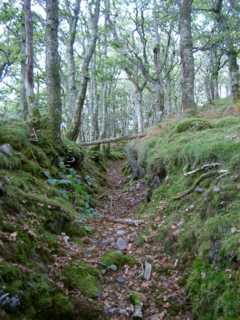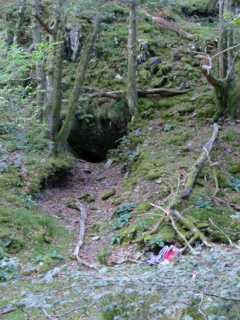Crafnant
| Alternative name | Coed Crafnant | ||||||||||||||||
|---|---|---|---|---|---|---|---|---|---|---|---|---|---|---|---|---|---|
| Location | SH621291 (Area map showing location.) | ||||||||||||||||
| Parish | Llanbedr | ||||||||||||||||
| Owners |
|
||||||||||||||||
| Production and Employment |
|
||||||||||||||||
| Transport | Track leading via Pont Crafnant to Cwm Bychan road at SH61642891 | ||||||||||||||||
| Remains | Mostly surface workings in woodland. (October 2002) | ||||||||||||||||

In Coed Crafnant.
Solicitors’ letters and papers exist concerning the lease of mines on Crafnant farmlands by Robert Prys Owen of Ael y bryn, Dyffryn to Thomas O Williams of the Cambrian Manganese Co. between September 1917 and December 1918 [GAS DAO: Z/DAM/630]. In July 1918 Williams reminds Owen that he (Williams) is waiting for a take note for manganese at Crafnant and says if a take note is not to be granted then what about “the wood on south side of the valley”. The papers include a draft take note and two draft leases.
The tip and cutting marked ‘Possible manganese mine’ on the plan originates from two entrances. The entrance in line with the cutting leads to a short horizontal level which appears to be a mineral trial. The entrance on the right at the end of the cutting leads to a short strike-aligned level which may have been a trial on the manganese bed.
There are also remains of copper mines (described as “lately opened” in 1853 [MJ 1853: p. 637]) which were worked 1869–1891, manager Pearce [Morrison 1975: 84]. A location of SH622289 (the more northerly of the two copper mines on the plan) is given for this and there are references in Stock Exchange Loan and Company Prospectuses 1824–1880, The Mining Journal 1847–1859 and the Home Office List of Mines 1886–1887 [Wilkinson 2003: 12480]. There are the remains of a dressing floor and a small (3 m x 3 m internal dimensions) smithy at this location.

